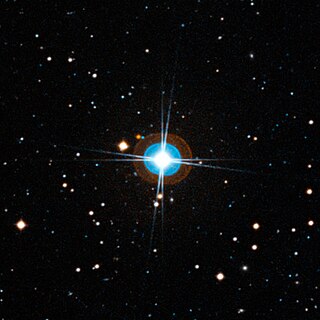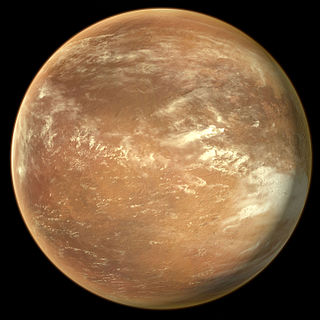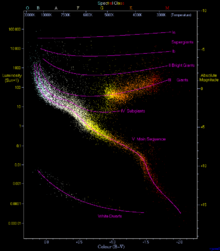HD 179949 is a 6th magnitude star in the constellation of Sagittarius. It is a yellow-white dwarf, a type of star hotter and more luminous than the Sun. The star is located about 90 light years from Earth and might be visible under exceptionally good conditions to an experienced observer without technical aid; usually binoculars are needed.

HD 40307 is an orange (K-type) main-sequence star located approximately 42 light-years away in the constellation of Pictor, taking its primary name from its Henry Draper Catalogue designation. It is calculated to be slightly less massive than the Sun. The star has six known planets, three discovered in 2008 and three more in 2012. One of them, HD 40307 g, is a potential super-Earth in the habitable zone, with an orbital period of about 200 days. This object might be capable of supporting liquid water on its surface, although much more information must be acquired before its habitability can be assessed.

Nu2 Lupi (ν2 Lupi) is a 6th magnitude G-type main-sequence star located approximately 48 light-years away in the constellation of Lupus. The physical properties of the star are similar to those of the Sun, though Nu2 Lupi is significantly older.
HD 204313 is a star with two and possibly three exoplanetary companions in the southern constellation of Capricornus. With an apparent magnitude of 7.99, it is an eighth magnitude star that is too faint to be readily visible to the naked eye. The star is located at a distance of 157 light years from the Sun based on parallax measurements, but it is drifting closer with a radial velocity of −10 km/s.

HD 10180, also designated 2MASS J01375356-6030414, is a Sun-like star in the southern constellation Hydrus that is notable for its large planetary system. Since its discovery, at least six exoplanets have been observed orbiting it, and some studies have proposed up to nine potential planets, which would make it potentially the largest of all known planetary systems, including the Solar System.

HD 114613 is a fifth magnitude yellow subgiant that lies 66.7 light-years away in the constellation of Centaurus. The star may be host to a long-period giant planet.

HD 40307 e is an extrasolar planet candidate suspected to be orbiting the star HD 40307. It is located 42 light-years away in the direction of the southern constellation Pictor. The planet was discovered by the radial velocity method, using the European Southern Observatory's HARPS apparatus by a team of astronomers led by Mikko Tuomi at the University of Hertfordshire and Guillem Anglada-Escude of the University of Göttingen, Germany.
HD 40307 f is an extrasolar planet orbiting the star HD 40307. It is located 42 light-years away in the direction of the southern constellation Pictor. The planet was discovered by the radial velocity method, using the European Southern Observatory's HARPS apparatus by a team of astronomers led by Mikko Tuomi at the University of Hertfordshire and Guillem Anglada-Escude of the University of Göttingen, Germany. The existence of planet was confirmed in 2015.
HD 20003 is a star in the southern constellation Hydrus. With an apparent visual magnitude of 8.39, this yellow-hued star is much too faint to be visible to the naked eye. It is located at a distance of 136.6 light years from the Sun based on parallax. HD 20003 is drifting closer with a radial velocity of −16 km/s, and is predicted to come to within 97 light-years in around 1.4 million years from now.
HD 93385 is a star in the southern constellation of Vela. At an apparent visual magnitude of 7.5, it is too faint to be seen with the unaided eye. Parallax measurements made using the Gaia spacecraft show an annual shift of 23.15 mas. This is equivalent to a physical separation of around 141 light years from the Sun. It is drifting further away with a radial velocity of +47.8 km/s.
HD 45184 is a star in the southern constellation of Canis Major. It is a yellow-hued star near the lower limit of visibility to the naked eye with an apparent visual magnitude of 6.37. The star is located at a distance of 71.65 light years from the Sun based on parallax. It is drifting closer with a radial velocity of −3.8 km/s.
HD 96700 is the Henry Draper Catalogue designation for a star in the equatorial constellation of Hydra. It has an apparent visual magnitude of 6.51, which puts it below the limit that can be seen with the naked eye by a typical observer. Based upon parallax measurements, this star is around 83 light years away from the Sun. It is drifting further away with a radial velocity of 12.8 km/s.
HD 215152 is the Henry Draper Catalogue designation for a star in the zodiac constellation of Aquarius. It has an apparent visual magnitude of 8.13, meaning it is too faint to be seen with the naked eye. Parallax measurements provide distance estimates of around 70 light years. The star has a relatively high proper motion, moving across the sky at an estimated 0.328 arc seconds per year along a position angle of 205°.
HD 7449 is a binary star system about 126 light-years way. The primary star, HD 7449 A, is a main-sequence star belonging to the spectral class F9.5. It is younger than the Sun. The primary star is slightly depleted of heavy elements, having 80% of solar abundance.

HD 189567 is a G3V star located 58.5 light years away, in the constellation of Pavo. The star HD 189567 is also known as Gliese 776, CD-67 2385, and HR 7644.
HD 39194 is a star located in the southern circumpolar constellation Mensa. It has an apparent magnitude of 8.07, making it readily visible in binoculars but not to the naked eye. The object is relatively close at a distance of 86 light years but is receding with a heliocentric radial velocity of 13.9 km/s.
HD 21693 is a star in the constellation Reticulum. It has an apparent visual magnitude of 7.94, therefore it is not visible to the naked eye. From its parallax measured by the Gaia spacecraft, it is located at a distance of 108.6 light-years (33.3 parsecs) from Earth.






